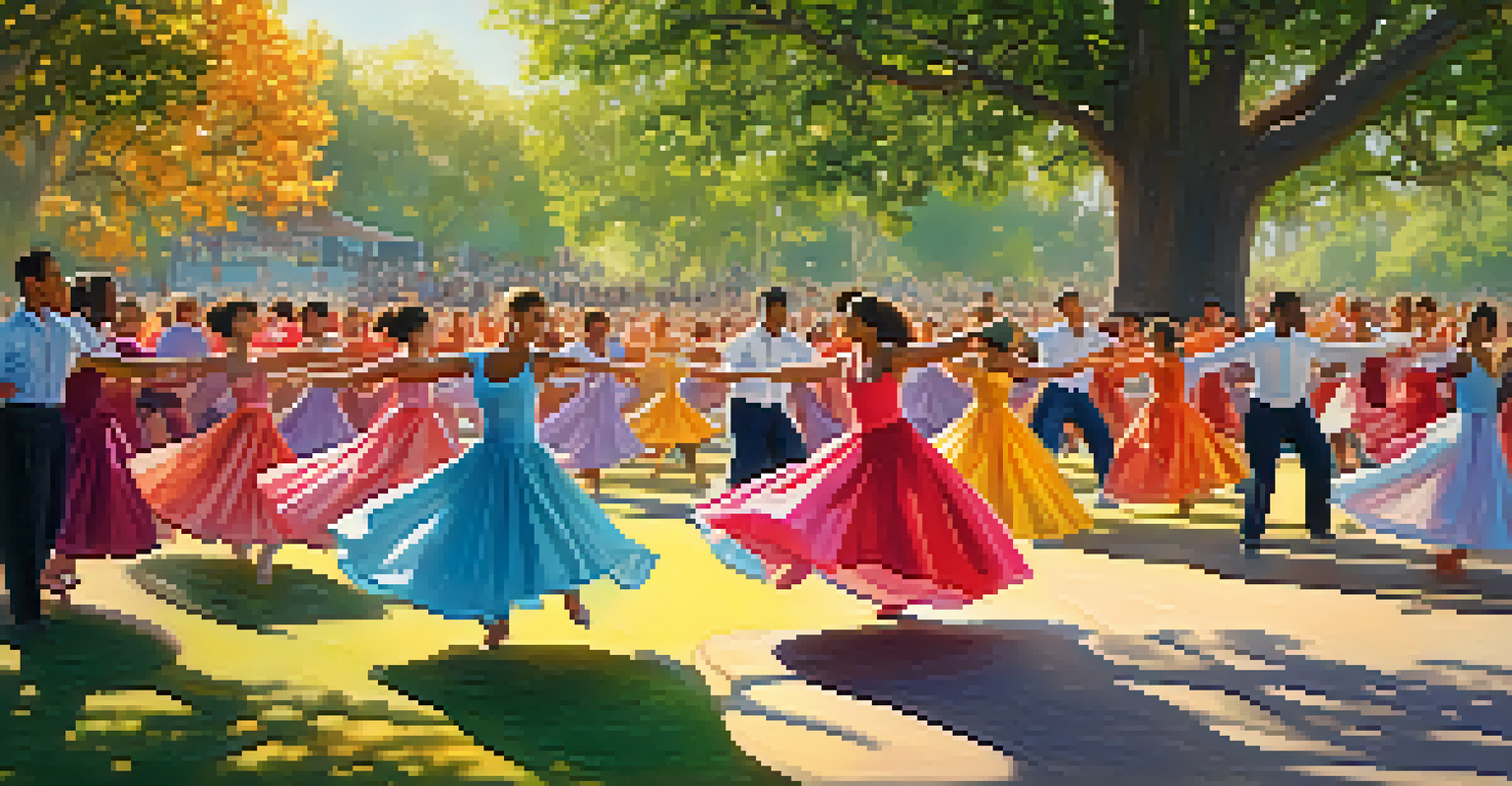The Importance of Dance Pedagogy in Contemporary Education

Understanding Dance Pedagogy and Its Relevance
Dance pedagogy refers to the art and science of teaching dance. It combines techniques, styles, and educational theories to create a comprehensive learning experience. Understanding this concept is crucial in contemporary education, as it transforms dance from mere performance into a rich learning tool.
Dance is the hidden language of the soul.
Incorporating dance pedagogy into the curriculum allows educators to address not just physical skills but also emotional and cognitive development. When students engage in dance, they learn about discipline, creativity, and expression. This holistic approach nurtures well-rounded individuals who can thrive in various aspects of life.
Moreover, dance pedagogy emphasizes inclusivity, encouraging participation from students of all backgrounds and abilities. By creating a supportive environment, educators can foster a sense of community and belonging, which is essential for effective learning.
Enhancing Cognitive Skills Through Dance
One of the key benefits of dance pedagogy is its positive impact on cognitive skills. Dance requires memorization of movements and sequences, which enhances memory and concentration. This mental engagement can translate into improved performance in academic subjects.

Additionally, dance promotes critical thinking and problem-solving abilities. As students learn to interpret music and movement, they develop analytical skills that are applicable beyond the dance studio. This can help them navigate challenges in other areas of their education and life.
Dance Enhances Cognitive Skills
Dance pedagogy boosts memory, concentration, and critical thinking, benefiting students in academics and daily life.
Moreover, the rhythmic and spatial awareness cultivated through dance can enhance mathematical skills. Just as dancers must understand patterns and timing, students can apply these concepts to better grasp mathematical principles, making learning more integrated and enjoyable.
Fostering Emotional Expression and Well-Being
Dance serves as a powerful medium for emotional expression, allowing students to communicate feelings in a non-verbal way. This is particularly beneficial in today's educational landscape, where mental health awareness is paramount. Engaging in dance can provide an outlet for stress relief and emotional release.
The dance is a poem of which each movement is a word.
Through the practice of dance, students learn to connect with their emotions, fostering self-awareness and empathy. They can explore a range of feelings, from joy to sadness, in a safe and supportive environment. This emotional depth can enhance their interpersonal skills and relationships with peers and teachers.
Furthermore, dance encourages a sense of accomplishment as students master new skills and techniques. This boosts their confidence and self-esteem, essential components for overall well-being. By integrating dance into the educational framework, we can support students' emotional health alongside their academic growth.
Promoting Physical Health and Fitness
Dance is an excellent way to promote physical health among students. It combines cardiovascular exercise with strength and flexibility training, making it a fun and engaging alternative to traditional workouts. As students participate in dance classes, they develop healthier habits and a better appreciation for their bodies.
Incorporating dance into the school curriculum can combat issues like obesity and sedentary lifestyles. By introducing movement in a creative way, educators can inspire students to stay active while having fun. This can lead to lifelong habits of physical activity and a healthier lifestyle overall.
Promotes Emotional Well-Being
Engaging in dance fosters emotional expression, self-awareness, and confidence, supporting overall mental health.
Moreover, the physical benefits of dance extend beyond fitness. Students often experience improved coordination and balance, which are critical skills not only in dance but in everyday life. By emphasizing these aspects, dance pedagogy contributes to the overall physical literacy of students.
Cultivating Social Skills and Teamwork
Dance is inherently social, encouraging collaboration and teamwork among students. Whether in partner dancing or group choreography, students learn to communicate effectively and work harmoniously with others. These skills are invaluable in both academic and professional settings.
Through dance, students experience the importance of trust and mutual respect. Working closely with peers fosters relationships that can lead to lifelong friendships. Moreover, the shared experience of learning and performing together can create a strong sense of camaraderie and belonging.
Additionally, dance can help bridge cultural gaps, as it often incorporates diverse styles and traditions. By learning about various dance forms, students gain a broader understanding of different cultures, promoting inclusivity and appreciation for diversity.
Incorporating Technology in Dance Education
In the digital age, incorporating technology into dance pedagogy can enhance the learning experience. Tools like video analysis and online tutorials allow students to receive immediate feedback and access resources beyond the classroom. This integration can make learning more interactive and engaging.
Virtual platforms also enable students to connect with peers and teachers globally, expanding their dance education beyond geographical boundaries. This can lead to unique collaborations and a broader perspective on dance as an art form. Embracing technology prepares students for a future where digital literacy is essential.
Encourages Teamwork and Inclusivity
Dance promotes collaboration and respect, helping students build social skills and appreciate diverse cultures.
However, it's important to strike a balance between technology and traditional methods. While technology can enhance learning, the core values of dance—movement, expression, and connection—should remain at the forefront. By blending both approaches, educators can create a well-rounded dance curriculum.
The Future of Dance Pedagogy in Education
As we look to the future, the role of dance pedagogy in education is likely to expand. Increasing recognition of the benefits of arts education is encouraging more schools to integrate dance into their curricula. This shift reflects a growing understanding of the importance of holistic education that nurtures both mind and body.
Moreover, as educational systems adapt to meet the needs of diverse learners, dance pedagogy can provide valuable strategies for differentiation. Teachers can tailor dance instruction to accommodate various learning styles and abilities, making it accessible to all students.

Ultimately, the future of dance pedagogy hinges on collaboration between educators, artists, and policymakers. By advocating for the inclusion of dance in education, we can create environments that celebrate creativity and foster personal growth for every student.